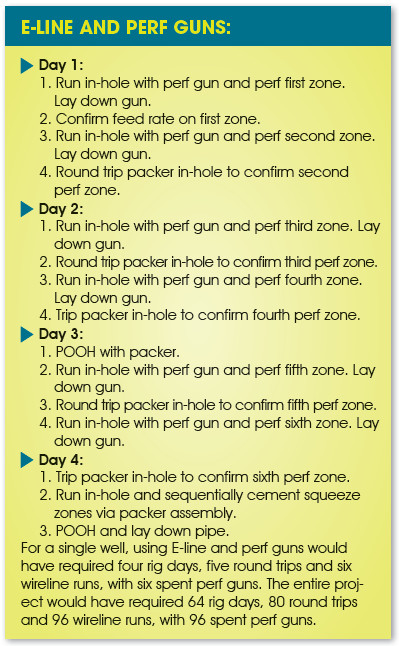The basic technologies associated with the plugging and abandoning (P&A) of wells has not changed significantly since the 1970s, as the National Petroleum Council pointed out in its North American Resource Development Study. Water-based slurries of cement and drilling mud are still the basic materials used to plug most wells, although progress has been made in use of additives to customize the cements and muds for specific types of wells.
Recent shale gas developments have rediscovered some P&A issues in the forms of older oil or gas wells that never were adequately plugged but which now pose possible cross-contamination or leakage risks. Furthermore, eventual retirement of uneconomical shale gas wells must address P&A practices that are specific to issues affecting gas wells and especially horizontal gas wells.
The lack of progress in P&A practices is attributable to absence of a long-term vision and inattention to corresponding research that recognizes the benefits of P&A to oil and gas development projects. Specific findings are that:
• Benefits from reduced operational costs and/or increased production, especially in redeveloped older fields, generally have been underappreciated;
• By plugging wells correctly, future environmental issues related to fluid or gas leakage can be avoided, thereby preserving savings otherwise eroded by remediation or litigation costs; and
• Research has lagged on materials and methods for plugging wells, although advances in technologies for drilling and completion should be applicable to practices in P&A.
Conventional tools used for P&A operations have certainly seen advances; for example, service companies have made numerous improvements in shaped-charge technology for perforating (perf) guns. However, such tools still have limitations and drawbacks that can only be overcome by a step change in P&A methods.
Hydromechanical perforating
A new approach to perforating has the potential to eliminate the explosive perf gun, a major risk in most types of completion and well abandonment operations. For P&A operations in particular, the Gator hydromechanical perforating tool also has demonstrated efficiency improvements over conventional perforating-gun methods.
The tool itself is simple. In essence, stackable pistons responding to hydraulic pressure force cutter blades out of the tool housing and into the casing. As this happens, the inner mandrel in the tool’s “dump sub” moves up, exposing vent holes to the annulus, which produces a visible pressure drop that indicates a successful cut. Because it’s not a gun that has to be reloaded, the tool is reusable without retrieval.
Because of the mechanical nature of the perforating process, there is no damage associated with the perforations, unlike the large damage area associated with explosive perforations. Cuts can be indexed in-hole for a spiral effect, which improves fluid sweep.
Sixteen-well P&A program results
A six-zone 16-well P&A project was recently performed for a large North American operator using the hydromechanical perforating tool and a packer. This successful project provides a contrast to how the same project would have been conducted with a conventional e-line and perf guns (see shadeboxes).


In both cases, the well was prepped, with the producing zone being plugged.
For the 16-well project the hydromechanical perforating tool saved the operator about $380,000 in direct costs. Even more important were the potential savings associated with the substantial risk reduction from the elimination of explosive perf-gun handling and use.
In another application, the tool was used by an operator for remediation of low cement tops at time of abandonment. Using the tool combined with a packer system, the operator completed cuts at the required geological intervals while isolating previous cuts. The operator also could conduct independent feed rates or attempt to establish circulation to surface. Over a six-well abandonment project, this operator gained operational efficiency over traditional perforating systems from the elimination of the need to trip tubing for each cut while maintaining a sufficient flow area to cement through. In this project the operator cemented through a single cut without increases in pumping pressures as a result of pressure losses across the entry point.
Perf efficiency
Flow area measurements show greater perf efficiency over conventional perf guns. A conventional perf gun provides a total flow area per charge of 0.74 sq. in. and a total flow area with 16 shots per meter (five shots per foot) of 3.7 sq. in.
The equivalent hydromechanical perforating tool provides a total flow area per hole of 1.71 sq. in. and a total flow area per cut (four holes) of 6.84 sq. in.—nearly double the flow area.
Hydromechanical perforating technology offers considerable efficiency improvements over conventional explosive perf guns. This technology can be applied beneficially in completions, production, P&A and water injection well integrity. But of even greater value is the incalculable improvement hydromechanical perforating makes to personnel safety on the rig floor.
Recommended Reading
Not Sweating DeepSeek: Exxon, Chevron Plow Ahead on Data Center Power
2025-02-02 - The launch of the energy-efficient DeepSeek chatbot roiled tech and power markets in late January. But supermajors Exxon Mobil and Chevron continue to field intense demand for data-center power supply, driven by AI technology customers.
Oil, Gas and M&A: Banks ‘Hungry’ to Put Capital to Work
2025-01-29 - U.S. energy bankers see capital, generalist investors and even an appetite for IPOs returning to the upstream space.
Riverstone’s Leuschen Plans to IPO Methane-Mitigation-Focused SPAC
2025-01-21 - The SPAC will be Riverstone Holdings co-founder David Leuschen’s eighth, following the Permian Basin’s Centennial Resources, the Anadarko’s Alta Mesa Holdings and the Montney’s Hammerhead Resources.
Utica Oil Player Ascent Resources ‘Considering’ an IPO
2025-03-07 - The 12-year-old privately held E&P Ascent Resources produced 2.2 Bcfe/d in the fourth quarter, including 14% liquids from the liquids-rich eastern Ohio Utica.
The Private Equity Puzzle: Rebuilding Portfolios After M&A Craze
2025-01-28 - In the Haynesville, Delaware and Utica, Post Oak Energy Capital is supporting companies determined to make a profitable footprint.
Comments
Add new comment
This conversation is moderated according to Hart Energy community rules. Please read the rules before joining the discussion. If you’re experiencing any technical problems, please contact our customer care team.





